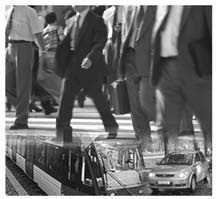|
专题推荐:词解十七大
The opening of the No 5 metro line and the slashing of the fare by a third to 2 yuan are a tangible benefit for Beijing's commuters.
Encumbered by the structural layout of the old city, there are no major roads going north-south through downtown Beijing. Driving north-south through areas within the Second Ring Road has been dreadful for all motorists. Of the existing three metro lines, No 1 passes through the city from east to west, No 2 runs underneath the Second Ring Road and the half-ring No 13 travels mainly in the northern suburb.
Now, with the northern-southern Line 5 joining the metro network, traffic conditions in the eastern part of Beijing, where most of the capital's corporate and entertainment sectors are located, are fairly relieved.

My niece, who lives in Beiqijia, a northern suburb near the Sixth Ring Road but works in the downtown Jianguomen area, told me she spent four hours and 30 yuan each day commuting between home and work because she took the Beijing-Chengde Expressway. Now she can get to work in just 40 minutes and spends only 2 yuan riding Line 5. She only needs to drive a few kilometers from her home to the metro station. The authorities have set up parking lots at both ends of the line. The parking charges are only 2 yuan for metro passengers. "Now I spend only 6 yuan a day," my niece said.
The route has saved her at least 500 yuan ($66) a month. Like her, many of the commuters living near the northern and southern ends of the line have abandoned driving.
The authorities have long tried to persuade private car owners to use the public transport system instead of driving but have never succeeded. Now the question has been settled in a part of Beijing overnight with the opening of a most needed block-free traffic line and a cut in the metro fare.
Given the huge difference in travel time and cost before and after the new move, who would not give up driving for public transport?
This example illustrates that so long as the authorities make sure a new way of life they advocate is tangibly beneficial, the citizens will naturally follow it. Let's again take the public transport system as an example. Before more underground lines are built, buses will remain the main means of public transport. However, they are no faster than private cars even though there are exclusive bus lanes in some streets. Most of the time, the lanes are occupied by other vehicles.
In my opinion, the government should take more forceful measures to ensure the smooth traveling of buses on the exclusive lanes. For example, two lanes, rather than one, can be reserved for buses in major streets (Beijing has built many new broader trunk roads in recent years).
Another reason for the slow moving buses is that those that run along the express ring roads cannot use the overpasses because the stops are usually set too close to the bridges. If the stops are set a little further away from the bridges and a lane for buses constructed over the bridges, the traveling speed of buses will be greatly raised.
And if bus speed on major streets and along the ring roads is quickened, the whole city's traffic will be greatly improved.
These two suggestions will cause inconvenience to other vehicles. But so long as public buses become ostensibly faster, more motorists will park their cars at home and choose public transport.
I hope the municipal government will learn from the experience of Line 5 and its related improvement and do more things that are tangibly beneficial to the citizens.
Email: liushinan@chinadaily.com.cn
(China Daily 10/17/2007 page9)
我要看更多专栏文章
|